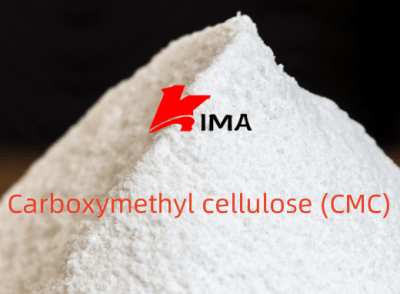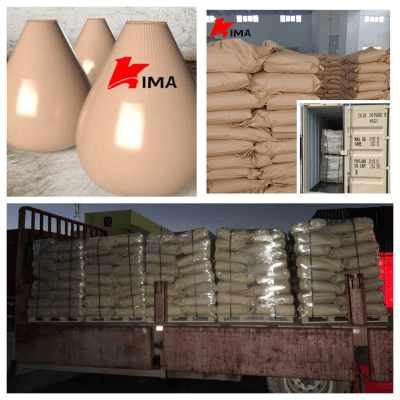Carboxymethyl cellulose (CMC) is an important anionic, water-soluble polymer compound. Due to its excellent thickening, dispersing, film-forming, bonding, and suspending properties, it is widely used in the ceramic industry. CMC plays an irreplaceable technical role in ceramic body preparation, glaze suspension, printing and decoration, and press molding.

1. Performance Characteristics of CMC
CMC is produced from natural cellulose through an etherification reaction. Its molecules contain carboxymethyl (–CH₂COONa) substituents, thus retaining the polymer properties of cellulose while exhibiting excellent hydrophilicity and ionization. Its main characteristics are as follows:
Strong Thickening: CMC forms high-viscosity solutions in water, significantly increasing the viscosity of the system even at low addition levels.
Excellent Suspending and Dispersing Properties: CMC molecular chains form a spatial network structure in aqueous solutions, effectively preventing particle sedimentation or aggregation.
Strong Film-Forming and Adhesive Properties: Upon drying, the solution forms a dense, transparent film on the ceramic surface, enhancing the bonding strength of the ceramic body. Excellent electrolyte resistance: Suitable for salt-containing systems, maintaining stable rheological properties before high-temperature firing.
Biodegradable, non-toxic, and environmentally friendly: CMC is naturally derived, friendly to both the human body and the environment, and in line with green manufacturing concepts.
2. Application of CMC in Ceramic Greenware
In the ceramic greenware preparation process, CMC is primarily used as a plasticizer and binder. Adding an appropriate amount of CMC to the greenware improves the plasticity and forming properties of the powder.
Improving Greenware Rheological Properties: The CMC solution evenly coats the particles, enhancing the lubricity within the greenware, improving the greenware flowability and facilitating extrusion or slip casting.
Improving Greenware Strength: Before drying, CMC forms a stable molecular network structure, enhancing the greenware strength and preventing cracking and chipping.
Optimizing Drying Shrinkage: CMC slows the evaporation rate, ensuring a more uniform drying process and reducing the risk of greenware deformation and cracking. In pressed ceramic powders, CMC is generally added at a level of 0.1% to 0.5%, significantly improving the powder's compressibility and green body density, enhancing subsequent sintering quality.
3. Application of CMC in Ceramic Glazes
Glaze is a key component in forming a smooth glaze layer on the ceramic surface, and its stability directly impacts the appearance and quality of the finished product. As a glaze suspending agent and thickener, CMC plays a key role in glaze slurry preparation:
Preventing glaze sedimentation and stratification: CMC improves the viscosity and flow balance of the glaze slurry, ensuring a long-term, uniform suspension of solid particles and preventing sedimentation.
Improving glaze slurry sagging properties: CMC modulates the thixotropy of the glaze slurry, enabling easy flow and uniform film formation during glazing. It also rapidly increases viscosity after glazing, reducing sagging.
Improving glaze surface smoothness and gloss: During the sintering process, CMC decomposes and burns, leaving uniform pores that facilitate gas discharge from the glaze and prevent pinhole and bubble defects. Strengthening the bond between glaze and body: CMC has strong film-forming properties, effectively improving glaze adhesion and preventing deglazing.
The typical CMC dosage in glaze slurries for household ceramics, architectural tiles, and craft ceramics is 0.2% to 0.8%, and should be optimized based on the glaze particle size, specific gravity, and application method.
4. Application of CMC in Ceramic Printing and Decoration
CMC is often used as a printing medium or pattern carrier in decorative processes such as ceramic painting, screen printing, and roller printing.
Improving the rheological properties of printing materials: CMC can control the viscosity and thixotropy of printing pastes, ensuring clear lines and preventing spreading.
Improving printing adhesion and drying: The thin film formed by CMC ensures that pigments adhere firmly to the body surface, drying evenly and without cracking.
Improving pattern resolution and color performance: CMC's uniform dispersion properties ensure fine distribution of pigment particles, resulting in more vivid and rich colors after firing.

5. Usage Tips and Process Optimization
Dissolution Method: CMC should be slowly dispersed and stirred in cold water to avoid clumping. It can be mixed with a small amount of dry powder first or dispersed in hot water before cooling to dissolve.
pH Control: The optimal pH range is 6-9. Acidic environments may cause CMC to degrade and become ineffective.
Addition Order: The CMC solution should be added after the powder is dispersed, usually before or after mixing the glaze slurry or clay.
Storage Stability: The solution should be prepared and used immediately. Prolonged storage can lead to viscosity loss and mold.
Carboxymethyl cellulose, a ceramic additive with comprehensive performance and reasonable cost, has become an indispensable raw material in the ceramic industry. It plays a key role in strengthening the ceramic body, stabilizing the glaze, and achieving fine printing. It not only improves the surface quality and molding efficiency of ceramic products, but also meets the modern ceramic industry's requirements for green, environmentally friendly, and energy-saving production. With the continuous development of high-performance CMC varieties, its application prospects in high-end architectural ceramics, functional ceramics, and 3D printing ceramics will expand.
Post time: Oct-27-2025
